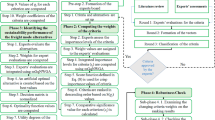Abstract
A shortest path problem on a network in the presence of fuzzy arc lengths is focused in this paper. The aim is to introduce the shortest path connecting the first and last vertices of the network which has minimum fuzzy sum of arc lengths among all possible paths. In this study a solution algorithm based on the extension principle of Zadeh is developed to solve the problem. The algorithm decomposes the fuzzy shortest path problem into two lower bound and upper bound sub-problems. Each sub-problem is solved individually in different \(\alpha\) levels to obtain the shortest path, its fuzzy length and its associated membership function value. The proposed method contains no fuzzy ranking function and also for each \(\alpha\)-cut, it gives a unique lower and upper bound for the fuzzy length of the shortest path. The algorithm is examined over some well-known networks from the literature and its performance is superior to the existent methods.





Similar content being viewed by others
References
Atsalakis G (2014) New technology product demand forecasting using a fuzzy inference system. Oper Res Int J 14:225–236
Bazaraa MS, Jarvis JJ, Sherali HD (2010) Linear programming and network flows. Wiley, New York
Blue M, Bush B, Puckett J (2002) Unified approach to fuzzy graph problems. Fuzzy Sets Syst 125:355–368
Cappanera P, Scaparra M (2011) Optimal allocation of protective resources in shortest-path networks. Transp Sci 45(1):64–80
Carlsson C, Fullér R (2013) Probabilistic versus possibilistic risk assessment models for optimal service level agreements in grid computing. IseB 11(1):13–28
Chuang TN, Kung JY (2006) A new algorithm for the discrete fuzzy shortest path problem in a network. Appl Math Comput 174:660–668
Deng Y, Chen Y, Zhang Y, Mahadevan S (2012) Fuzzy Dijkstra algorithm for shortest path problem under uncertain environment. Appl Soft Comput 12:1231–1237
Dou Y, Zhu L, Wang HS (2012) Solving the fuzzy shortest path problem using multi-criteria decision method based on vague similarity measure. Appl Soft Comput 12:1621–1631
Dubois D, Prade H (1980) Fuzzy Sets and systems: theory and applications. Academic Press, New York
Fullér R, Mezei J, Várlaki P (2011) An improved index of interactivity for fuzzy numbers. Fuzzy Sets Syst 165:56–66
Fullér R, Canós-Darós L, Canós-Darós MJ (2012) Transparent fuzzy logic based methods for some human resources problems. Revista Electrónica de Comunicaciones y Trabajos de ASEPUMA 13:27–41
Hadi-Vencheh A, Mokhtarian MN (2011) A new fuzzy MCDM approach based on centroid of fuzzy numbers. Expert Syst Appl 38(5):5226–5230
Hassanzadeh R, Mahdavi I, Mahdavi-Amiri N, Tajdin A (2013) A genetic algorithm for solving fuzzy shortest path problems with mixed fuzzy arc lengths. Math Comput Model 57:84–99
Jayswal A, Stancu-Minasian I, Banerjee J, Stancu AM (2015) Sufficiency and duality for optimization problems involving interval-valued invex functions in parametric form. Oper Res Int J 15:137–161
Ji X, Iwamura K, Shao Z (2007) New models for shortest path problem with fuzzy arc lengths. Appl Math Model 31:259–269
Kumar A, Kaur M (2011) A new algorithm for solving shortest path problem on a network with imprecise edge weight. Appl Appl Math 6(2):602–619
Kumar A, Kaur A (2012) Methods for solving unbalanced fuzzy transportation problems. Oper Res Int J 12(3):287–316
Liu ST (2008) Fuzzy profit measures for a fuzzy economic order quantity model. Appl Math Model 32:2076–2086
Liu ST (2015) Fractional transportation problem with fuzzy parameters. Soft Comput. doi:10.1007/s00500-015-1722-5
Liu ST, Kao C (2004) Solving fuzzy transportation problems based on extension principle. Eur J Oper Res 153:661–674
Mahdavi I, Nourifar R, Heidarzade A, Mahdavi-Amiri N (2009) A dynamic programming approach for finding shortest chains in a fuzzy network. Appl Soft Comput 9:503–511
Mahmoodi-Rad A, Molla-Alizadeh-Zavardehi S, Dehghan R, Sanei M, Niroomand S (2014) Genetic and differential evolution algorithms for the allocation of customers to potential distribution centers in a fuzzy environment. Int J Adv Manuf Technol 70(9–12):1939–1954
Moazeni S (2006) Fuzzy shortest path problem with finite fuzzy quantities. Appl Math Comput 183:160–169
Nayeem SMA, Pal M (2005) Shortest path problem on a network with imprecise edge weight. Fuzzy Optim Decis Mak 4:293–312
Okada S (2004) Fuzzy shortest path problems incorporating interactivity among paths. Fuzzy Sets Syst 142(3):335–357
Okada S, Soper T (2000) A shortest path problem on a network with fuzzy arc lengths. Fuzzy Sets Syst 109:129–140
Ramik L (1986) Extension principles in fuzzy optimization. Fuzzy Sets Syst 19:29–35
Sakawa M, Katagiri H, Matsui T (2012) Interactive fuzzy stochastic two-level integer programming through fractile criterion optimization. Oper Res Int J 12(2):209–227
Sengupta A, Pal TK (2000) On comparing interval numbers. Eur J Oper Res 127:29–43
Tajdin A, Mahdavi A, Mahdavi-Amiri N, Sadeghpour-Gildeh B (2010) Computing a fuzzy shortest path in a network with mixed fuzzy arc lengths using α-cuts. Comput Math Appl 60:989–1002
Yager RR (1986) A characterization of the extension principle. Fuzzy Sets Syst 18:205–217
Yano H, Sakawa M (2014) Interactive fuzzy programming for multiobjective fuzzy random linear programming problems through possibility-based probability maximization. Oper Res Int J 14:51–69
Zadeh LA (1987) Fuzzy sets as a basis for a theory of possibility. Fuzzy Sets Syst 1:3–28
Zareei A, Zaerpour F, Bagherpour M, Noora AL, Hadi-Vencheh A (2011) A new approach for solving fuzzy critical path problem using analysis of events. Expert Syst Appl 38(1):87–93
Zimmermann HJ (1996) Fuzzy set theory and its applications. Kluwer-Nijhoff, Boston
Acknowledgments
This study was supported by Firouzabad Institute of Higher Education. The authors are grateful for this financial support. The authors are also grateful to the editors and the referees of the journal for their helpful and constructive comments that improved the quality of the paper.
Author information
Authors and Affiliations
Corresponding author
Rights and permissions
About this article
Cite this article
Niroomand, S., Mahmoodirad, A., Heydari, A. et al. An extension principle based solution approach for shortest path problem with fuzzy arc lengths. Oper Res Int J 17, 395–411 (2017). https://doi.org/10.1007/s12351-016-0230-4
Received:
Revised:
Accepted:
Published:
Issue Date:
DOI: https://doi.org/10.1007/s12351-016-0230-4




